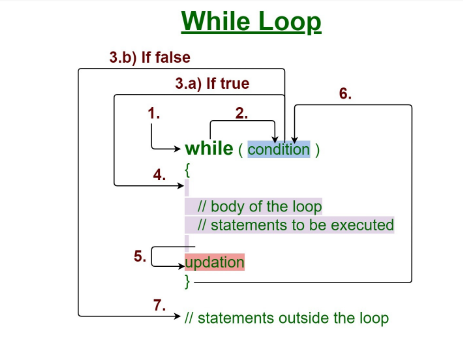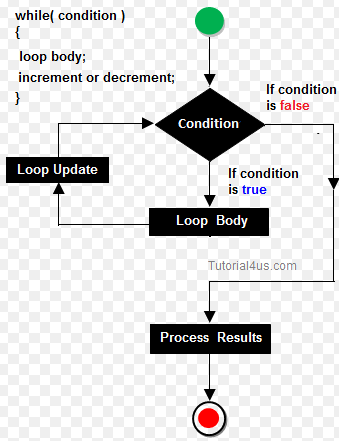What Are Loops?
Looping in programming language is a feature which facilitates the execution of a set of instructions/functions repeatedly while some condition evaluates to be true. A program executes the sequence of statements many times until the stated condition becomes false. A loop consists of two parts, a body of a loop and a control statement. The control statement is a combination of some conditions that direct the body of the loop to execute until the specified condition becomes false.
While Loop
In computer programming languages, a while loop is a control flow statement that allows code to be executed repeatedly based on a given Boolean condition. The while loop can be thought of as a repeating if statement, in a while loop a condition is evaluated before processing a body of the loop. If a condition is true then the body of a loop is executed. Now after execution of the loop body, the control returns again at the beginning and the condition is examined if it is true, the same process is executed until the condition becomes false. Once the condition becomes false, the control terminates/goes out of the loop and that marks the end of its life cycle.
After coming out of the loop, the control goes to the statements which are immediately after the loop. The body of a loop can contain more than one statement. If it contains only one statement, then the curly braces are not compulsory. It is usually important to consider using the curly braces even when there is a single statement in the body.

Do-While Loop
A do-while loop is a control-flow statement that executes a block of code at least once and then repeatedly executes the block or not, depending on a given Boolean condition at the end of the block. The do while construct consists of a process symbol and a condition. At the beginning, the code within the block is executed and then the condition is examined. If the condition is true the code within the block is re-executed. The process repeats until the condition becomes false.

Unlike the while loop which tests the condition before the code within the block is executed, the do-while loop is an exit-condition loop, in the sense that, the code must always be executed first and then the expression or test condition examined. If it is true, the code executes the body of the loop again. If the expression is false, the loop terminates and control transfers to the statement following the do-while loop.
Also Read: Difference Between If-else And Switch Case
Difference Between While And Do-While Loop In Tabular Form
| BASIS OF COMPARISON | WHILE LOOP | DO-WHILE LOOP |
| Main Feature | The main feature of the while loop is that it’s an entry controlled loop. | The main feature of the do while is an exit controlled loop. |
| Statements | Given that the condition is checked first, statements may or may not get executed. | Given that the condition is checked later, the body statements will execute at least once. |
| Iterations | The iterations do not occur if the condition at the first iteration appears false. | In Do-while loop the iteration occurs at least once even if the condition is false at the first iteration. |
| Semicolon | Semicolon (;) is not used in while loop. | Semicolon (;) is used in Do-while loop. |
| Controlling Condition | In while loop, the controlling condition appears at the start of the loop. | In Do-while loop the controlling condition appears at the end of the loop. |
| Nature | The code is short and therefore it takes much less time to execute. | The code is relatively long and therefore it takes extra time to execute. |
Also Read: Difference Between Exit Controlled And Entry Controlled Loop
Similarities Between While And Do-while loop
- Both while loop and do-while loop are iterative control structures in any programming language.
- Both are conditional loops because they are based on conditions (Boolean expressions).
- In both case, the value of Boolean expression (true/false) determines whether the loop exits or not.
